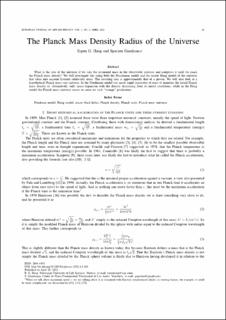| dc.contributor.author | Haug, Espen Gaarder | |
| dc.contributor.author | Spavieri, Gianfranco | |
| dc.date.accessioned | 2023-01-09T08:29:39Z | |
| dc.date.available | 2023-01-09T08:29:39Z | |
| dc.date.created | 2022-05-06T08:27:55Z | |
| dc.date.issued | 2022 | |
| dc.identifier.issn | 2684-4451 | |
| dc.identifier.uri | https://hdl.handle.net/11250/3041774 | |
| dc.description.abstract | What is the size of the universe if we take the estimated mass in the observable universe and compress it until we reach the Planck mass density? We will investigate this using both the Friedmann model and the recent Haug model of the universe that takes into account Lorentz relativistic mass. The resulting size is approximately that of a proton. We will also look at a hypothetical Planck mass size universe. In the Friedmann model one needs rapid expansion of mass to maintain the initial Planck mass density or, alternatively, only space expansion with the density decreasing from its initial conditions, while in the Haug model the Planck mass universe seems to cause no such “strange” predictions. | |
| dc.description.abstract | The Planck Mass Density Radius of the Universe | |
| dc.language.iso | eng | en_US |
| dc.title | The Planck Mass Density Radius of the Universe | en_US |
| dc.title.alternative | The Planck Mass Density Radius of the Universe | en_US |
| dc.type | Journal article | en_US |
| dc.type | Peer reviewed | en_US |
| dc.description.version | publishedVersion | |
| dc.source.volume | 4 | en_US |
| dc.source.journal | European Journal of Applied Physics | en_US |
| dc.source.issue | 2 | en_US |
| dc.identifier.doi | 10.24018/ejphysics.2022.4.2.165 | |
| dc.identifier.cristin | 2021959 | |
| cristin.ispublished | true | |
| cristin.fulltext | original | |
| cristin.qualitycode | 1 | |
